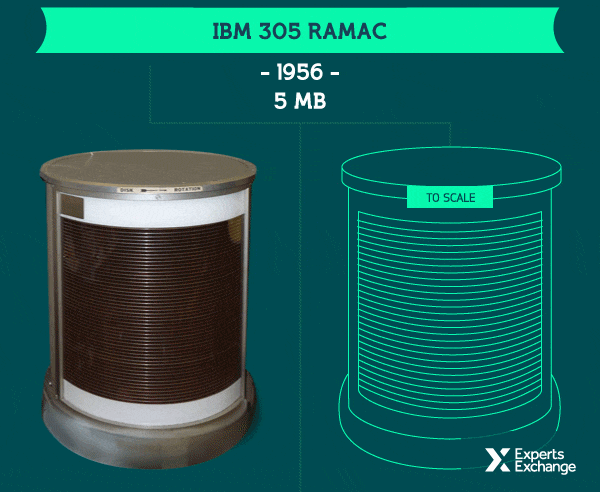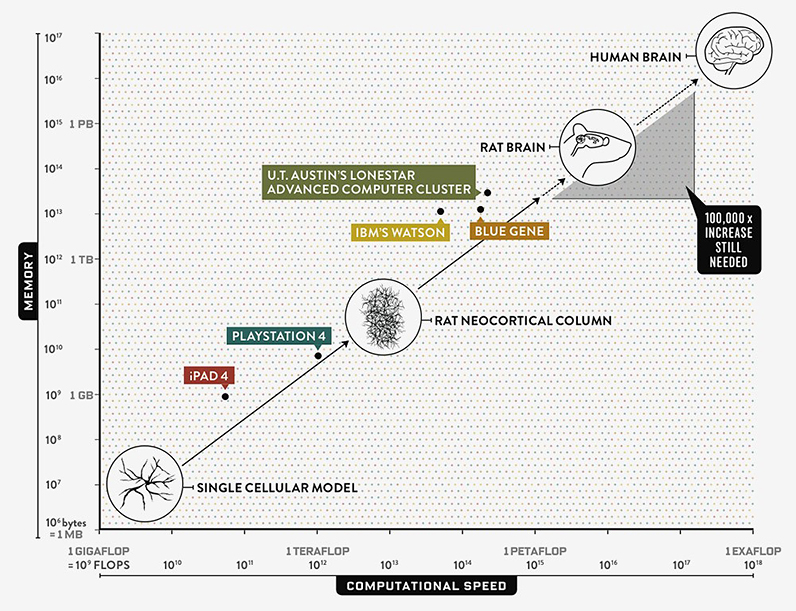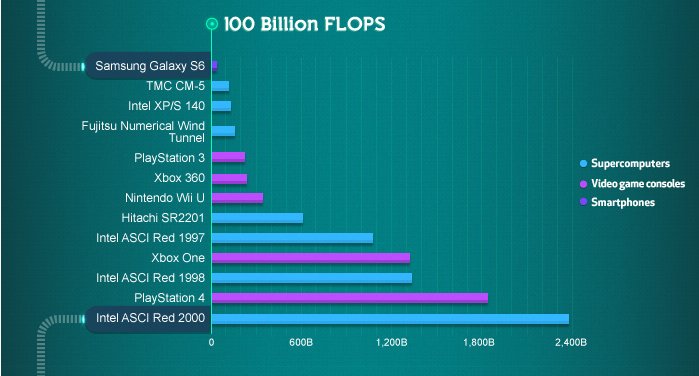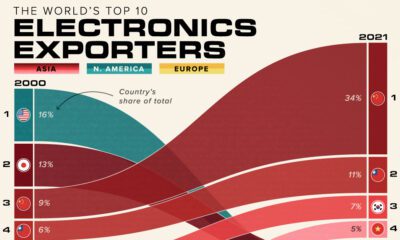Technology
Visualizing the Trillion-Fold Increase in Computing Power
On July 20, 1969, millions of people received an inspirational jolt from watching two brave astronauts take humankind’s first steps on the moon. Rightly so, those astronauts, Neil Armstrong and Buzz Aldrin, are now household names to many – however, their Apollo Guidance Computer (AGC) remains the unsung hero that made their moon landing possible in the first place.
With processing power equivalent to a pair of Nintendo consoles, the AGC wasn’t flashy. But despite its technical limitations, the AGC functioned admirably as the interface for guidance, navigation, and control of the spacecraft to get humans to their first lunar destination.
To Infinity and Beyond?
If a pair of Nintendo consoles can get us to the moon, there’s no telling what the future may hold as computing power continues to grow.
Today’s infographic comes to us from Experts Exchange, and it visualizes the 1 trillion-fold increase in computing performance from 1956 to 2015.

The Incredible Shrinking Hard Disk
In the 1970s, data storage equipment was serious business. The IBM 305 RAMAC, for example, weighed a ton and measured 16 square feet. The RAMAC’s storage capacity? Just 5MB.
Thankfully, hard disks are no longer the size of filing cabinets. The animation below visualizes just how compact terabytes of storage have become.

Computing in the Real World
A relatable touchpoint for many people will be ever-changing graphics quality of video games.
The journey from Atari’s pixelated stick figures to today’s crisp, hyper-realistic graphics is a surprisingly good visual aid to help us understand increases in computing power over many years.

The journey from Pong to Call of Duty is inexorably linked to processing power. As the comprehensive list below demonstrates, modern gaming systems are so powerful that even the revolutionary Xbox 360 now looks quaint in comparison.
| YEAR | MFLOPS | CONSOLE |
|---|---|---|
| 1976 | 0 | Fairchild Channel F (Pong) |
| 1977 | 0 | Atari 2600 |
| 1983 | 0 | NES |
| 1986 | 0 | Atari 7800 |
| 1988 | 0 | Sega Genesis |
| 1990 | 0 | SNES |
| 1991 | 0 | Sega CD |
| 1994 | 0 | Sony PlayStation |
| 1994 | 0 | Sega Saturn |
| 1996 | 200 | Nintendo 64 |
| 2000 | 6,200 | Sony PlayStation 2 |
| 2005 | 240,000 | Xbox 360 |
| 2006 | 459,200 | Sony PlayStation 3 |
| 2013 | 1,228,800 | Xbox One |
| 2013 | 1,843,200 | Sony PlayStation 4 |
Our ExaFLOP Future
Though performance drivers are flattening out, supercomputing continues to hit new milestones. The next one on the list is exascale computing – and at that level, machines will be capable of a million-trillion calculations a second.
Why do we even need computers that powerful? For one, some of the biggest challenges facing humankind are extremely complicated, and we just don’t have the computing power to tackle them as effectively as we could. Two relevant examples are climate modeling and life sciences.
All these advances are pushing us closer to a major symbolic milestone: computers as powerful and complex as the human brain.

Technology
Visualizing AI Patents by Country
See which countries have been granted the most AI patents each year, from 2012 to 2022.

Visualizing AI Patents by Country
This was originally posted on our Voronoi app. Download the app for free on iOS or Android and discover incredible data-driven charts from a variety of trusted sources.
This infographic shows the number of AI-related patents granted each year from 2010 to 2022 (latest data available). These figures come from the Center for Security and Emerging Technology (CSET), accessed via Stanford University’s 2024 AI Index Report.
From this data, we can see that China first overtook the U.S. in 2013. Since then, the country has seen enormous growth in the number of AI patents granted each year.
| Year | China | EU and UK | U.S. | RoW | Global Total |
|---|---|---|---|---|---|
| 2010 | 307 | 137 | 984 | 571 | 1,999 |
| 2011 | 516 | 129 | 980 | 581 | 2,206 |
| 2012 | 926 | 112 | 950 | 660 | 2,648 |
| 2013 | 1,035 | 91 | 970 | 627 | 2,723 |
| 2014 | 1,278 | 97 | 1,078 | 667 | 3,120 |
| 2015 | 1,721 | 110 | 1,135 | 539 | 3,505 |
| 2016 | 1,621 | 128 | 1,298 | 714 | 3,761 |
| 2017 | 2,428 | 144 | 1,489 | 1,075 | 5,136 |
| 2018 | 4,741 | 155 | 1,674 | 1,574 | 8,144 |
| 2019 | 9,530 | 322 | 3,211 | 2,720 | 15,783 |
| 2020 | 13,071 | 406 | 5,441 | 4,455 | 23,373 |
| 2021 | 21,907 | 623 | 8,219 | 7,519 | 38,268 |
| 2022 | 35,315 | 1,173 | 12,077 | 13,699 | 62,264 |
In 2022, China was granted more patents than every other country combined.
While this suggests that the country is very active in researching the field of artificial intelligence, it doesn’t necessarily mean that China is the farthest in terms of capability.
Key Facts About AI Patents
According to CSET, AI patents relate to mathematical relationships and algorithms, which are considered abstract ideas under patent law. They can also have different meaning, depending on where they are filed.
In the U.S., AI patenting is concentrated amongst large companies including IBM, Microsoft, and Google. On the other hand, AI patenting in China is more distributed across government organizations, universities, and tech firms (e.g. Tencent).
In terms of focus area, China’s patents are typically related to computer vision, a field of AI that enables computers and systems to interpret visual data and inputs. Meanwhile America’s efforts are more evenly distributed across research fields.
Learn More About AI From Visual Capitalist
If you want to see more data visualizations on artificial intelligence, check out this graphic that shows which job departments will be impacted by AI the most.
-

 Markets1 week ago
Markets1 week agoU.S. Debt Interest Payments Reach $1 Trillion
-

 Business2 weeks ago
Business2 weeks agoCharted: Big Four Market Share by S&P 500 Audits
-

 Real Estate2 weeks ago
Real Estate2 weeks agoRanked: The Most Valuable Housing Markets in America
-

 Money2 weeks ago
Money2 weeks agoWhich States Have the Highest Minimum Wage in America?
-

 AI2 weeks ago
AI2 weeks agoRanked: Semiconductor Companies by Industry Revenue Share
-

 Markets2 weeks ago
Markets2 weeks agoRanked: The World’s Top Flight Routes, by Revenue
-

 Demographics2 weeks ago
Demographics2 weeks agoPopulation Projections: The World’s 6 Largest Countries in 2075
-

 Markets2 weeks ago
Markets2 weeks agoThe Top 10 States by Real GDP Growth in 2023















